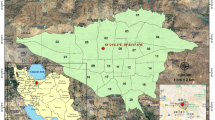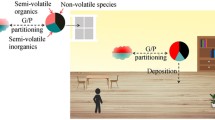Abstract
Outdoor PM2.5 easily flows into indoor and seriously influences indoor air quality due to its characteristics of flow, diffusion and penetration. It is a proper ‘gas’ tracer similar to CO2 to study building ventilation. Therefore, in this paper, a model for calculating air change rates by removing indoor PM2.5 was deduced. Also, some factors influencing the air change rate were qualitatively analyzed and the expression of possible air change rate error was given. The comparison between the results from PM2.5 removal method and the data from CO2 decay method validated the model. The relative error between the results of the two methods is less than 10%. On the basis of validating the model, this paper presented the research of air change rates in ten naturally ventilated house rooms in three Chinese cities. It is found that the rooms with the ventilation rates of 1.15–6.75 m3/h/person have inadequate ventilation.






Similar content being viewed by others
References
Bekoe G, Toftum J, Clausen G (2011) Modeling ventilation rates in bedrooms based on building characteristics and occupant behavior. Build Environ 46:2230–2237
Costanzo S, Cusumano A, Giaconia C (2011) Ventilation rates and unsatisfied percentage from Indoor CO2 concentration. Indoor Built Environ 20:232–245
Dimitroulopoulou C, Bartzis J (2014) Ventilation rates in European office buildings: a review. Indoor Built Environ 23:5–25
Du L, Batterman S, Godwin C, Rowe Z, Chin JY (2015) Air exchange rates and migration of VOCs in basements and residences. Indoor Air 25:598–609
Enai M, Shaw CY, Reardon JT (1990) On the multiple tracer gas techniques for measuring interzonal airflows in buildings. ASHRAE Trans 96:599–608
Gao JJ, Tian HZ, Cheng K, Lu L, Zheng M, Wang SX et al (2015) The variation of chemical characteristics of PM2.5 and PM10 and formation causes during two haze pollution events in urban Beijing. China Atmos Environ 107:1–8
Guo H, Morawska L, He C, Gilbert D (2008) Impact of ventilation scenario on air exchange rates and on indoor particle number concentrations in an air-conditioned classroom. Atmos Environ 42:757–768
Han Y, Qi M, Chen YL, Shen HZ, Liu J, Huang Y et al (2015) Influences of ambient air PM2.5 concentration and meteorological condition on the indoor PM2.5 concentrations in a residential apartment in Beijing using a new approach. Environ Pollut 205:307–314
Hang J, Li YG (2010) Ventilation strategy and air change rates in idealized high-rise compact urban areas. Build Environ 45:2754–2767
Ho KF, Ho SSS, Huang RJ, Chuang HC, Cao JJ, Han YM et al (2016) Chemical composition and bioreactivity of PM2.5 during 2013 haze events in China. Atmos Environ 126:162–170
Huang RJ, Zhang YL, Bozzetti C, Ho KF, Cao JJ, Han YM et al (2014) High secondary aerosol contribution to particulate pollution during haze events in China. Nature 514:218–222
Laverge J, Janssens A (2013) Optimization of design flow rates and component sizing for residential ventilation. Build Environ 65:81–89
Li MN, Zhang LL (2014) Haze in China: current and future challenges. Environ Pollut 189:85–86
Mendell MJ, Eliseeva EA, Spears M, Chan WR, Cohn S, Sullivan DP et al (2015) A longitudinal study of ventilation rates in California office buildings and self-reported occupant outcomes including respiratory illness absence. Build Environ 92:292–304
Miller SL, Leiserson K, Nazaroff WW (1997) Nonlinear least-squares minimization applied to a tracer gas decay for determining airflow rates in a two-zone building. Indoor Air 7:64–75
Mleczkowska A, Strojecki M, Bratasz L, Kozłowski R (2016) Particle penetration and deposition inside historical churches. Build Environ 95:291–298
Mousavi ES, Grosskopf KR (2015) Ventilation rates and airflow pathways in patient rooms: a case study of bioaerosol containment and removal. Ann Occup Hyg 59:1190–1199
Persily AK (2016) Field measurement of ventilation rates. Indoor Air 26:97–111
Samer M, Ammon C, Loebsin C, Fiedler M, Berg W, Sanftleben P et al (2011) Moisture balance and tracer gas technique for ventilation rates measurement and greenhouse gases and ammonia emissions quantification in naturally ventilated buildings. Build Environ 46:2230–2237
Santos HRR, Leal VMS (2012) Energy vs. ventilation rate in buildings: a comprehensive scenario-based assessment in the European context. Energy Build 54:111–121
Seppänen OA, Fisk WJ, Mendell MJ (1999) Association of ventilation rates and CO2 concentrations with health and other responses in commercial and institutional buildings. Indoor Air 9:226–252
Shen X, Zhang GQ, Bjerg B (2013) Assessments of experimental designs in response surface modelling process: estimating ventilation rate in naturally ventilated livestock buildings. Energy Build 62:570–580
Siegel JA (2016) Primary and secondary consequences of indoor air cleaners. Indoor Air 26:88–96
Teitel M, Ziskind G, Liran O, Dubovsky V, Letan R (2008) Effect of wind direction on greenhouse ventilation rate, airflow patterns and temperature distributions. Biosyst Eng 101:351–369
Thatcher TL, Lunden MM, Revzan KL, Sextro RG, Brown NJ (2003) A concentration rebound method for measuring particle penetration and deposition in the indoor environment. Aerosol Sci Technol 37:847–864
Tian M, Wang HB, Chen Y, Yang FM, Zhang XH, Zou Q et al (2016) Characteristics of aerosol pollution during heavy haze events in Suzhou, China. Atmos Chem Phys 16:7357–7371
Turanjanin V, Vutiaevic B, Jovanovic M, Lamirkov N, Lazovic I (2014) Indoor CO2 measurements in Serbian schools and ventilation rate calculation. Energy 77:290–296
Waters JR, Simons MW (1987) The evaluation of contaminant concentrations and air flows in a multizone model of a building. Build Environ 22:305–315
Zhao B, Zeng JL (2009) A simple model to study the influence of fluctuating airflow on the effective air exchange rate when using natural ventilation. Build Simul 2:63–66
Zhou GQ, Yang F, Geng FH, Xu JM, Yang X, Tie XX (2014) Measuring and modeling aerosol: relationship with haze events in Shanghai, China. Aerosol Air Qual Res 14:783–792
Zhou ZH, Liu YR, Yuan JJ, Zuo J, Chen GY, Xu LY et al (2016) Indoor PM2.5 concentrations in residential buildings during a severely polluted winter: a case study in Tianjin, China. Renew Sust Energy Rev 64:372–381
Acknowledgments
This work was supported by the National Natural Science Foundation of China (51506101) and the Priority Academic Program Development of Jiangsu Higher Education Institutions and Research (PAPD).
Author information
Authors and Affiliations
Corresponding author
Ethics declarations
Conflict of interest
All the authors declare that they have no conflicts of interest.
Additional information
Editorial responsibility: Mohamed Fathy Yassin.
Electronic supplementary material
Below is the link to the electronic supplementary material.
Rights and permissions
About this article
Cite this article
Ni, P.Y., Jin, H.C., Wang, X.L. et al. A new method for measurement of air change rate based on indoor PM2.5 removal. Int. J. Environ. Sci. Technol. 15, 2561–2568 (2018). https://doi.org/10.1007/s13762-017-1625-3
Received:
Revised:
Accepted:
Published:
Issue Date:
DOI: https://doi.org/10.1007/s13762-017-1625-3




